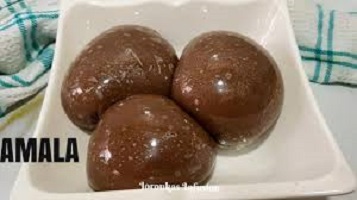Amala African Food (Yam Flour) – Brown Amala Food Recipe
Amala African Food (Yam Flour) – Brown Amala Food Recipe

Let me give you a quick rundown on this delicacy if you’re unfamiliar with it.
Amala is a traditional Nigerian meal eaten by the Yoruba ethnic group in the country’s western states. It’s manufactured using unripe plantain flour, yam flour, and/or cassava flour.
Before now, Amala is commonly eaten with Ewedu and Stew but in recent times Gbegiri (beans soup) has been introduced into the menu which has however made it more attractive and desirable.
In addition, it has become a staple meal in every Nigerian household. It has spread across Nigeria’s various dialects and has gained traction in every part of the country, as well as some parts of Africa.
Related articles on Amala African Food Recipe >>>
- Amala Food: How to Prepare Amala (Dark Brown Yam Flour)
- The Amala Food Nutritional Values | Health Benefits | Health Risk
- Amala Food Recipe | Easy Nigerian Food | Health Benefits
Table of Contents
Amala African Food
It’s no longer just Nigerian food; it’s also known as Amala African cuisine.
However, one advantage of this meal is that it may be consumed at any time of day; it digests quickly and easily due to its light nature.
This meal may turn you off at first glance; evidently, the eye eats first, followed by the tongue. You’ll want to eat this amazing dish every other day once you’ve decided to try it.
Amala is easy to make but then if you are not careful enough, it becomes fluffy, lumpy, and unenjoyable.
Relax if you have trouble preparing lump-free, fluffy, smooth Amala; with this recipe, you’ll have it under control.
What exactly is Amala African Food and what does it taste like?
It’s a Nigerian dish made from yam and/or cassava flour or unripe plantain flour, and it’s predominantly eaten by Yorubas, especially in Oyo state. Yam flour is made from peeled, dried yam that has been ground into flour.
It is often brownish.
It may interest you to know that Amala African Food is not only brown but white as well. Not many people are aware of this fact though.
The brown (Elubo in Yoruba) amala is made up of yam and/or unripe plantain flour while the white (Lafun in Yoruba) amala is made up of cassava flour only.
But our concentration here today is the brown African amala. The taste of the African meal is awesome and very earthy.
Amala African Food Health Benefits
- Minerals including copper, calcium, potassium, iron, manganese, and phosphorus are abundant in amala.
- Amala includes an enzyme that can be used as a natural alternative to hormone replacement in postmenopausal women. Amala is a good energy source.
- This African Swallow is high in Vitamin B6, which is required by the body to break down homocysteine, a chemical that damages blood vessel walls.
- Amala is high in HDL cholesterol, which helps to lower the risk of coronary heart disease and atherosclerosis.
- Amala is beneficial to pregnant women, and it is even recommended.
How to make Amala African Food
The brown Amala (Elubo) is prepared in this manner while the white Amala (Lafun) is prepared differently. So, here’s a step-by-step guide to making perfect Amala.
Let’s pretend that this Amala recipe is 101. Shall we? Hahaha!
Amala African Food Ingredients (Serves 2-3)
With this recipe, you will get perfect and smooth Amala all the time.
- 4 cups (1000ml) of Water
- 2 cups of Sifted Yam flour
- 1 cup (250ml) of hot water (reserved)
Directions
- Firstly, fill an electric kettle halfway with water and pour 4 cups into a pot.
- Secondly, cover the water and allow it to boil until bubbles appear, as seen in the image below.
- Thirdly, reduce the heat to low and add the yam flour all at once to the water, stirring/turning with a wooden spoon or spatula (omorogun) until it comes together but isn’t smooth. It takes around a minute to complete this process and make it smooth
- After that, pour the reserved 1 cup of water into the Amala, making a well in the center and sides with the wooden spoon, and steam the Amala for 1-2 minutes.
- Then, stir the amala for 1-2 minutes, or until it is completely smooth. Turn to the other side after some time has passed.
I prefer my Amala light with soup. If you want it to be less soft, use ¾ cup of water instead of 1 cup of water at stage 4.
Enjoy with Ewedu, Gbegiri, Fresh fish stew, Ogbono, Okra, or any other soup.
Cooking Tips on Amala African Food
- Firstly, use a pot with a handle you can grip tightly and never use a nonstick pot for amala.
- Most people make the error of stirring and adding yam flour a bit at a time. The amala will be lumpy as a result of this procedure.
- Before stirring, add all of the yam flour.
- However, if you leave Amala on the stove for too long, it will stretch out. The entire procedure should take around 4-5 minutes from the time you pour in the yam flour to the time you remove it.
African food palace Amala joint Near me in Lagos, Nigeria
- Abule Amala
- Amalatohsure
- Amala On The Island
- The Amala Place Canteen
- Amala 4 Real
- The Amala Ogbomosho
- Amala 730
- The Amala Tax Office
- Amala Place Coca-Cola Lagos Island
- The Amala Ibadan
- Amala Olatishe
- The Amala District, Traditional Food Kitchen
- Amala To Rewa
- Amala Kitchen
- Iya Amala
- Oya Okanlawon Amala Joint
- Amala Zone
- The Amala Bowl
- Amala Shitta
Akpu Vs Amala Vs Fufu – Different Nigerian Swallows
Among Akpu, Amala, and Fufu which is your best and why? which one is even more edible? Let me know in the comment section below
Amala Food Swallow: Health Benefits
Amala is a traditional Nigerian food made from yam flour. While it’s a staple dish in Nigeria, it’s not commonly known outside of West Africa. Here are some potential health benefits of Amala:
Good Source of Carbohydrates
Amala is primarily made from yam flour, which is rich in carbohydrates. Carbohydrates are the body’s primary source of energy, providing fuel for various bodily functions and physical activities.
Dietary Fiber
Yam flour used in making Amala contains dietary fiber, which aids in digestion, promotes bowel regularity, and helps prevent constipation.
A diet high in fiber is associated with a lower risk of various digestive disorders and may contribute to overall gut health.
Vitamins and Minerals
Yam, the main ingredient in Amala, is rich in various vitamins and minerals, including vitamin C, vitamin B6, potassium, manganese, and dietary antioxidants. These nutrients play essential roles in maintaining overall health, supporting immune function, and reducing the risk of chronic diseases.
Gluten-Free
Like many traditional African dishes, amala is naturally gluten-free, making it suitable for individuals with celiac disease or gluten intolerance.
Satiety
The combination of carbohydrates and dietary fiber in Amala can contribute to a feeling of fullness and satiety, which may help control appetite and support weight management when consumed as part of a balanced diet.
Low in Fat
Amala itself is low in fat, which can be beneficial for those aiming to reduce their fat intake or manage their weight.
Cultural Significance
While not a direct health benefit, the cultural significance of Amala should also be acknowledged.
Traditional foods like amala often hold cultural and social importance, promoting a sense of community and connection to cultural heritage.
It’s worth noting that the health benefits of amala can vary depending on factors such as portion size, cooking methods, and the ingredients used in accompanying soups or stews.
As with any food, enjoying amala as part of a balanced diet alongside a variety of other nutrient-rich foods is key to reaping its potential health benefits.



Pingback: Amala Nigerian Swallow Recipe - 9jafoods